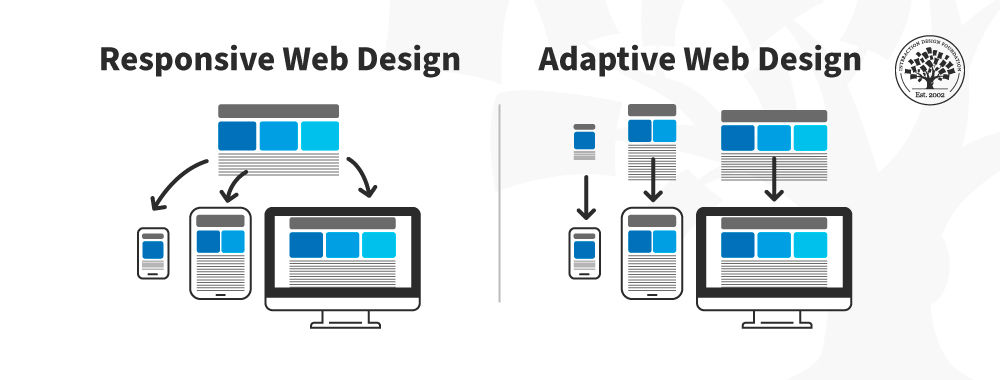Key Elements to Think About When Crafting Expert Web Design
Key Elements to Think About When Crafting Expert Web Design
Blog Article
Exploring the Impact of Receptive Website Design on Accessibility and Individual Fulfillment Across Different Gadgets
The emergence of responsive internet design (RWD) has changed the digital landscape, especially in improving access and individual contentment across a plethora of gadgets. By using adaptive user interfaces and versatile formats, RWD not just provides to diverse customer requirements but additionally deals with the critical importance of inclusivity in web experiences.

Interpretation of Responsive Internet Layout
Receptive Website Design (RWD) changes the customer experience across different devices by ensuring that web material adapts fluidly to various display sizes and positionings. This style strategy uses versatile grids, designs, and photos, in addition to CSS media questions, to produce a smooth browsing experience. By employing these techniques, RWD permits internet sites to automatically restructure and resize web content, making it easily accessible on tools ranging from home computer to mobile phones.
The core principle of RWD is to offer an optimum watching experience, that includes easy analysis and navigation without the demand for too much scrolling or resizing. This versatility is crucial in a digital landscape where users gain access to info with different devices with varying screen resolutions. RWD not only improves functionality yet likewise boosts tons times, as it usually utilizes a solitary codebase to offer multiple gadgets, decreasing the demand for different mobile sites.
Ultimately, Receptive Website design intends to create a natural and appealing customer experience, making certain that web content is visually appealing and functionally effective, no matter the tool being used. This flexibility is vital in meeting the diverse requirements these days's web individuals, promoting interaction and fulfillment across platforms.
Value of Ease Of Access
Exactly how can we make certain that all users, no matter of their capacities, can engage with internet content efficiently? Ease of access in web layout is of critical importance, as it fosters inclusivity and ensures equal accessibility to info for people with specials needs. This incorporates visual, acoustic, and cognitive impairments, calling for developers to take into consideration diverse individual needs.
Applying access attributes, such as alternative text for photos, keyboard navigating, and appropriate color contrast, allows users to connect with content seamlessly. Sticking to developed guidelines, such as the Internet Content Access Guidelines (WCAG), provides a structure for creating accessible internet experiences.
By focusing on ease of access, organizations not only adhere to legal requirements but likewise enhance their brand name reputation, showing a dedication to social responsibility. Available web sites frequently result in boosted functionality for all users, as functions made for inclusivity can profit a broader target market.
Ultimately, the value of ease of access goes beyond plain conformity; it has to do with developing a digital environment where every customer can browse, comprehend, and engage with content effectively, therefore improving the overall internet experience for everyone.
Customer Fulfillment Across Tools
Lots of individuals anticipate a smooth experience when accessing internet content throughout different devices, from desktop computers to smartphones. This expectation is rooted in the boosting diversity of tools and display sizes readily available navigate to this site today. Responsive web design (RWD) plays a vital role in satisfying these assumptions by guaranteeing that internet sites adjust fluidly to different display environments.
Customer fulfillment is considerably affected by the access and functionality of an internet site - web design. When users can quickly navigate, review, and interact with content despite the gadget they are utilizing, their general complete satisfaction increases. A well-implemented responsive style reduces the requirement for zooming or straight scrolling, which can lead and irritate individuals to higher bounce prices
Furthermore, customer contentment is additionally influenced by factors such as loading speed and visual charm. RWD strategies that maximize images and enhance code can improve performance, consequently adding to an extra enjoyable customer experience. As customers engage with web content that is tailored to their tool, they are much more most likely to invest time on the site, return for future gos to, and advise it to others. Ultimately, receptive website design promotes a favorable relationship in between customers and internet content across gadgets.
Influence On Mobile Users

The impact of RWD on mobile individuals expands beyond aesthetics; it considerably influences usability. A well-designed responsive site decreases the demand for extreme dig this scrolling and zooming, helping with a much more user-friendly communication. It fosters inclusivity by accommodating customers with differing capacities, making certain that those who count on mobile gadgets can access details with convenience.
Furthermore, mobile users take advantage of faster packing times, as RWD maximizes sources based on device capabilities. This effectiveness is critical, as mobile individuals frequently seek fast details and may desert websites that stop working to pack quickly. Ultimately, the assimilation of responsive web design is vital for satisfying the varied demands of mobile users, boosting their total experience and encouraging continued engagement with the material.
Best Practices for Execution
Executing responsive website design (RWD) properly calls for adherence to numerous ideal practices that guarantee optimal performance throughout devices. Utilizing a liquid grid design is crucial; this enables components to resize proportionally based on the screen dimensions, providing a smooth experience. Furthermore, utilizing versatile pictures guarantees that visuals range correctly without shedding top quality or triggering format concerns.

Making sure that all interactive aspects are touch-friendly and enhancing web page load times significantly add to customer satisfaction and accessibility. By adhering to these finest practices, companies can produce a durable and accessible internet presence that meets the diverse needs of users throughout different gadgets.
Conclusion
In verdict, responsive internet layout plays a vital duty in improving availability and customer complete satisfaction throughout diverse devices. Inevitably, the combination of finest techniques in responsive layout cultivates inclusivity, lowers bounce rates, and advertises better individual involvement.
The development of responsive web design (RWD) has actually transformed the electronic landscape, especially in boosting accessibility and customer complete satisfaction throughout a wide variety go now of gadgets.Receptive Web Layout (RWD) transforms the individual experience across numerous devices by making certain that web material adapts fluidly to various display sizes and orientations. Ultimately, responsive internet design promotes a favorable connection between users and internet content across devices.
Over 54% of global web traffic currently stems from mobile devices, highlighting the vital significance of optimizing web experiences for this customer base. Receptive web layout (RWD) plays a pivotal duty in enhancing access and customer fulfillment for mobile individuals.
Report this page